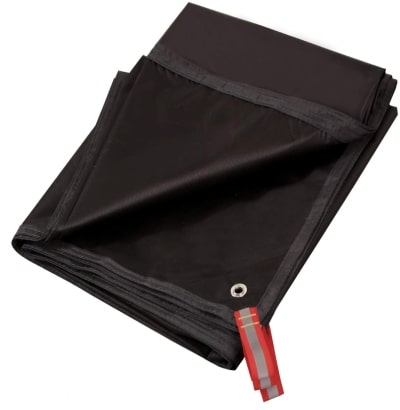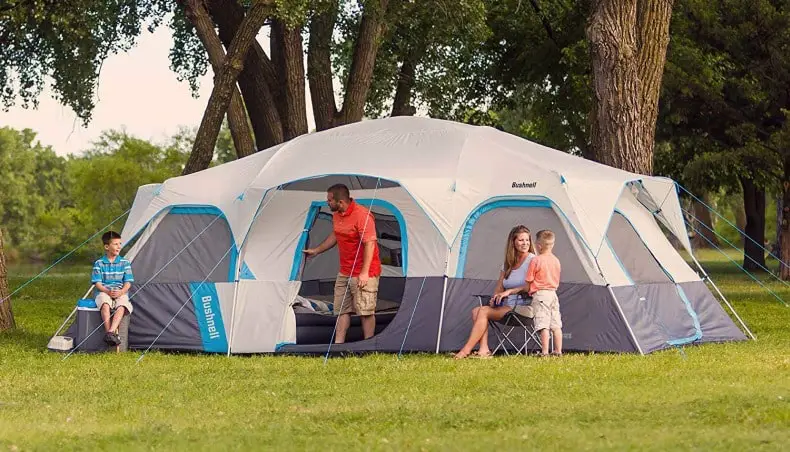Many of us are going camping right about now before it gets to the super cold time of year. As a result, we want to make sure we camp with the right tent as well as the right materials. Taking the right stuff with you can be quite important. Yet some are slightly questionable for many.
One of those questionable items is known as a “tent footprint.” Many will wonder if they need a tent footprint.
A tent footprint is not necessary but is highly recommended as it helps protect the ground fabric of the tent from abrasion which could damage the tent. A tent footprint also acts as a barrier to moisture.
A tent footprint is nothing more than a ground cover for your tent. Yet saying “nothing more” is a bit unfair, as a ground cover can be pretty important. We know, we know. The world has been putting up tents for hundreds of years in some form or another.
It’s hard to recall anyone complaining about the lack of ground coverage in history, right? To be fair, while that might be true…this does not mean that tent footprints are not useful. Just because we “used to” not use does not mean they are useless now at all.
Table of Contents
What Is The Actual Role Of A Tent Footprint?

This is a big question many have. When discussing the value of a tent footprint, many may misunderstand what they actually do. A footprint protects the tent floor as we mentioned but does not mean it helps your floor’s waterproof nature or insulation.
Rather, the main reason footprints are useful is simply due to how they protect the tent. We know, puzzling, right? Basically, let’s say your tent has a waterproof coating, for example. It will protect this coating as well as the potential damaging of the rest of the fabric.
Essentially, the true job of the footprint is abrasion safety. When people get into their tent, they will walk all over the place, roll around, or toss & turn. All of this is being done with your body weight, which can get pretty big for some campers.
This is not just involving one person, but literally, everyone who happens to get inside one tent too. Even if the tent is made for 4 people and you manage to fit in 6 instead.
The tent footprint helps protect the ground fabric on the actual ground and the fabric inside the tent itself. Some tent floors can be pretty thin. The potential damage that could happen to the bottom of your tent is endless.
Does It Help To Waterproof Or Insulate?
This is both a yes and no. Truly, tent footprints are not designed to be waterproof or to waterproof your tent. Instead, they protect the investment of the tent’s already included waterproof fabric.
Therefore, technically yes, they do help in waterproofing but also no, they don’t. Basically, they ensure the waterproof bottom remains waterproof. This insurance policy is a good thing to have when you need it most.
Is this the same concept on insulation? Not exactly. Just like with the waterproof situation, the tent footprint’s job technically is not to insulate. However, insulation is accomplished in many different ways. One of those ways is by using layers.
By having a footprint, you’re adding an extra layer between you and the true ground below you. Therefore, this extra layer of protection technically acts as another form of insulation. Not a bad thing to offer on a technicality in our book.
Should You Go Out And Get One? Make Your Own?

If you are looking for a new tent, we’d recommend you buy one with a tent footprint included in the price. The cost of the tent with a footprint does not differ drastically if at all compared to one without it. Thus, there is truly no reason not to get one with the added footprint.
However, if you already have a tent at home and do not want to go out and buy an entirely new one…then you can always buy one. Redcamp makes one you can get for about 20 bucks. That’s about the same price as a decent tarp.
If not, you can actually make one for pretty cheap too. If we were doing it, we’d consider making one first.
It is the cheaper option most of the time. Why not try the cheapest option first, eh?
There are many things you can use to act as a tent footprint too. Some people have had success using thick bed sheets. Where they put a few old ones together and cut them to get to the exact measurements of their tent floor.
Polyethylene:

Others use different materials, such as polyethylene sheeting. This is a form of thermoplastic, which holds up very well. This stuff is used in a lot of the plastic materials we use today, such as tubes and even some action figures.
Your local hardware store will have some form of polyethylene sheeting too. The average cost is roughly depending on the version of polyethylene you’re using. The main ones will be labeled something like HDPE, UHMW & HMWPE.
This is High-Density Polyethylene or HDPE is likely the most common you’ll run into. It is also likely the best version to get. Depending on the size of your tent, the price asked by most places will differ.
For something like a 4” x 8” version, you could spend about $5. Yet if you need more than this, especially a specific custom cut, the price could be significantly more. Compare something like this to a new tent footprint and you might be able to see if it’s just better to buy the footprint or not. Truly, this is all down to the cost.
So, do you need a footprint? You can get by without a footprint for sure, but ideally, it’s best. Pitching your tent on a footprint will help extend the life of your tent.







